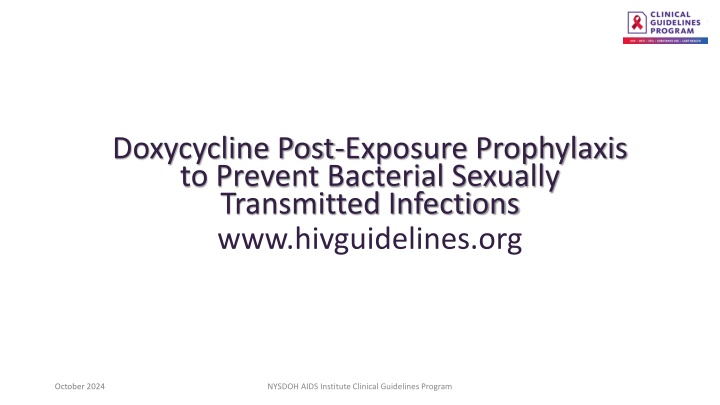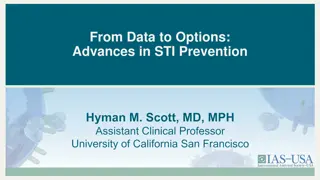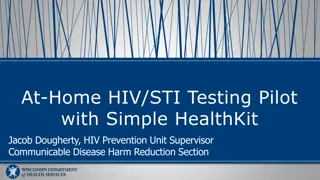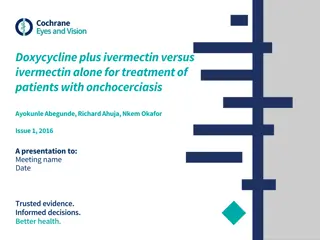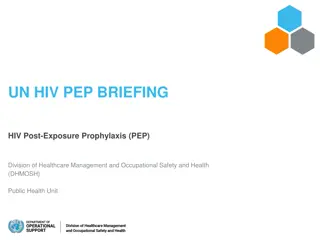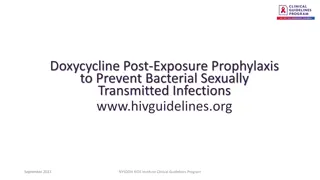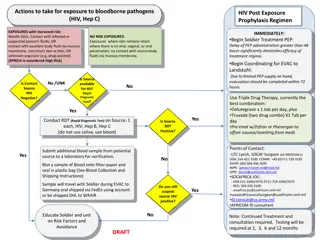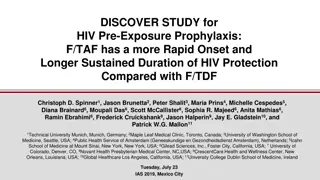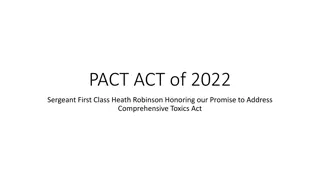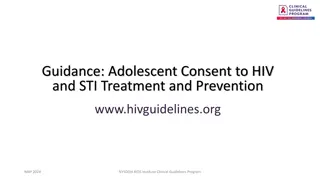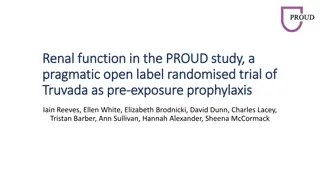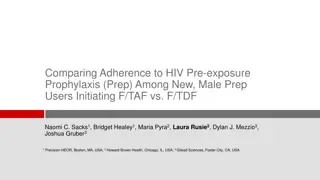Doxycycline Post-Exposure Prophylaxis for STI Prevention
This guideline outlines the use of doxycycline post-exposure prophylaxis (doxy-PEP) to prevent bacterial sexually transmitted infections (STIs) like syphilis, chlamydia, and gonorrhea. It provides evidence-based recommendations and practical considerations for prescribing doxy-PEP to at-risk individuals. The document emphasizes offering biomedically-based prevention strategies to cisgender men and transgender women engaging in condomless sex, considering factors like STI history and ongoing risk of exposure. Clinicians are advised on dosing regimens, patient education, screening protocols, and additional HIV prevention and treatment options in conjunction with doxy-PEP usage.
Download Presentation

Please find below an Image/Link to download the presentation.
The content on the website is provided AS IS for your information and personal use only. It may not be sold, licensed, or shared on other websites without obtaining consent from the author.If you encounter any issues during the download, it is possible that the publisher has removed the file from their server.
You are allowed to download the files provided on this website for personal or commercial use, subject to the condition that they are used lawfully. All files are the property of their respective owners.
The content on the website is provided AS IS for your information and personal use only. It may not be sold, licensed, or shared on other websites without obtaining consent from the author.
E N D
Presentation Transcript
Doxycycline Post-Exposure Prophylaxis to Prevent Bacterial Sexually Transmitted Infections www.hivguidelines.org October 2024 NYSDOH AIDS Institute Clinical Guidelines Program
Purpose of This Guideline Purpose of This Guideline The goals of this guideline are to: Summarize the available evidence regarding the use of doxy-PEP for preventing syphilis, chlamydia, and gonorrhea infections Provide evidence-based clinical recommendations for the use of doxy-PEP Present practical considerations for prescribing doxy-PEP October 2024 NYSDOH AIDS Institute Clinical Guidelines Program www.hivguidelines.org
Recommendations: Biomedical Prevention of STIs Recommendations: Biomedical Prevention of STIs Clinicians should offer doxy-PEP to cisgender men and transgender women who engage in condomless sex with partner(s) assigned male sex at birth and who: Have had a bacterial STI diagnosed within the past year (A1), or Have no or unknown history of STIs and ongoing risk of STI exposure (A2) Clinicians should engage in shared decision-making with cisgender men who are at ongoing risk of STI exposure and engage in condomless sex with multiple partners assigned female sex at birth, offering doxy-PEP on a case-by-case basis. (B3) October 2024 NYSDOH AIDS Institute Clinical Guidelines Program www.hivguidelines.org
Recommendations: Biomedical Prevention of Recommendations: Biomedical Prevention of STIs STIs, continued When prescribing doxy-PEP, clinicians should use the dosing regimen of oral doxycycline 200 mg taken ideally within 24 hours (up to 72 hours) after condomless sex (A1) and counsel patients (A*) on the key points for patient education outlined in Considerations for Doxy-PEP Implementation. For individuals taking doxy-PEP, clinicians should screen for HIV, chlamydia, gonorrhea, and syphilis at least every 3 months. (A1) Clinicians should offer HIV PrEP to individuals who do not have HIV and are initiating or using doxy-PEP. (A*) Clinicians should offer HIV treatment to individuals with HIV who are not on antiretroviral therapy and are initiating or using doxy-PEP. (A1) October 2024 NYSDOH AIDS Institute Clinical Guidelines Program www.hivguidelines.org
Key Points: Doxycycline as PEP Key Points: Doxycycline as PEP Doxy-PEP is not 100% effective in preventing bacterial STIs. There is insufficient evidence to recommend doxy-PEP to protect against STI acquisition through receptive vaginal sex. If doxy-PEP is used in individuals who may become pregnant, pregnancy testing should be performed, as doxycycline use should generally be avoided during pregnancy. It is essential to provide counseling and education to patients on the limitations of doxy-PEP and to emphasize that ongoing condom use and engagement in sexual health services is necessary, including but not limited to routine STI screening, STI testing for symptomatic patients, and STI treatment or evaluation after an STI exposure. Evaluation by a clinician after a known or possible STI exposure is necessary to determine whether treatment is needed. For individuals using doxy-PEP who are diagnosed with gonorrhea, chlamydia, or syphilis, treat according to the recommendations in the CDC STI Treatment Guidelines. October 2024 NYSDOH AIDS Institute Clinical Guidelines Program www.hivguidelines.org
Considerations for Doxy Considerations for Doxy- -PEP Implementation PEP Implementation Consideration(s) Comments Doxycycline hyclate delayed-release 200 mg oral tablet Doxycycline hyclate or monohydrate immediate-release 100 mg oral capsule or tablet (2 capsules or tablets taken together for a total of 200 mg) The immediate-release formulations are more widely available and usually cost less than the delayed- release formulation. As doxy-PEP, 200 mg of doxycycline should ideally be taken within 24 hours after condomless sex, up to 72 hours maximum. No more than 200 mg of doxycycline should be taken in a 24-hour period. Milk and vitamins containing positive cations (e.g., calcium, zinc, magnesium) should be avoided within 2 hours of taking doxycycline, because these interfere with doxycycline absorption and may lower doxycycline levels, potentially reducing efficacy. Available formulations Administration Contraindications, drug- drug interactions, and dose adjustments Doxy-PEP should not be used concurrently with other doxycycline therapy (or any other tetracycline-class antibiotic) for treatment or prevention of a health condition (e.g., acne, rosacea, malaria prophylaxis). No significant drug-drug interactions exist between doxycycline and ARVs used for HIV treatment or PrEP. No known drug reactions exist between doxycycline and gender-affirming hormone therapies. No doxycycline dose adjustments are indicated for patients with renal dysfunction. Doxycycline is generally contraindicated during pregnancy because of potential adverse effects on the fetus. October 2024 NYSDOH AIDS Institute Clinical Guidelines Program www.hivguidelines.org
Considerations for Doxy Considerations for Doxy- -PEP Implementation PEP Implementation, continued Consideration(s) Comments GI adverse effects are common; taking doxycycline with food may help alleviate nausea or GI upset. Symptoms including nausea, vomiting, and reflux can be severe enough to require cessation of doxycycline. Esophageal injury and irritation can occur. Doxycycline should be taken with an 8-oz glass of water and the individual should remain upright for 30 minutes to 1 hour after dosing. Skin photosensitivity and phototoxicity can occur; wearing sunscreen, limiting sun exposure, and avoiding tanning beds can help prevent sunburn and other skin injury. Intracranial hypertension is a rare but serious adverse effect. Refractory headaches or vision changes should be evaluated promptly by a clinician. Doxycycline use may select for antibiotic-resistant organisms, which can cause infections in some circumstances and can disrupt the microbiome. A 30- to 90-day supply is recommended, with actual number of pills to be determined by anticipated or actual dosing frequency during that time (see dose quantity below). Dose quantity: For delayed-release doxycycline 200 mg tablets, the quantity dispensed should not exceed 90 doses per 3 months. For immediate-release 100 mg capsules or tablets, the quantity dispensed should not exceed 180 doses per 3 months. The quantities above are the maximum number to be dispensed; many patients will not need such a large quantity. Shared decision-making can determine the lowest quantity needed based on the frequency of condomless sexual encounters during the prescribing interval. Adverse effects Supply of doxy-PEP medications October 2024 NYSDOH AIDS Institute Clinical Guidelines Program www.hivguidelines.org
Considerations for Doxy Considerations for Doxy- -PEP Implementation PEP Implementation, continued Consideration(s) Comments Follow-up and laboratory monitoring Engage patients taking doxy-PEP in ongoing comprehensive sexual health services that include STI screening, HIV PrEP, immunizations, and other health promotion strategies as indicated. At least every 3 months: Screen for syphilis, HIV if not previously diagnosed, gonorrhea, and chlamydia (including extragenital testing when indicated), ensuring that tests have been obtained before providing a doxy-PEP prescription refill. Screen for HBV at initiation, and screen for HCV at least annually. Offer HIV PrEP or HIV treatment as needed. Assess for ongoing doxy-PEP needs and continue in shared decision-making as new evidence becomes available. The doxycycline package insert advises periodic monitoring of hepatic function, renal function (specifically BUN), and CBC with prolonged therapy. Such monitoring may not be necessary with intermittent dosing. Medication administration instructions and contraindications: See above. Protective effect: Doxy-PEP is not 100% effective and is not effective against all STIs. For cisgender men and transgender women at risk of STIs who were engaged in routine sexual healthcare, doxy-PEP reduced the likelihood of an STI diagnosis by >50%. Evaluation by a clinician after a possible STI exposure is necessary to determine whether treatment is needed. Adverse effects: Doxycycline can cause GI adverse effects, photosensitivity, and esophageal irritation, which can be mitigated using strategies noted above. Long-term doxycycline use may increase the risk of developing an antibiotic- resistant infection. The potential long-term effects of doxy-PEP use are not known at this time. Ongoing screening: Screening for STIs every 3 months is necessary while taking doxy-PEP. Routine HIV testing should continue in individuals at risk of HIV. Key points for patient education October 2024 NYSDOH AIDS Institute Clinical Guidelines Program www.hivguidelines.org
Need Help? Need Help? NYSDOH AIDS Institute Clinical Guidelines Program www.hivguidelines.org
Access the Guideline Access the Guideline www.hivguidelines.org > Doxycycline Post-Exposure Prophylaxis to Prevent Bacterial Sexually Transmitted Infections Also available: Printable pocket guide and PDF NYSDOH AIDS Institute Clinical Guidelines Program www.hivguidelines.org
